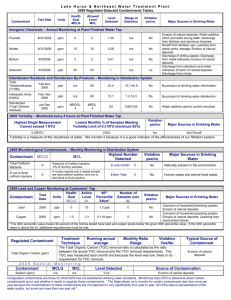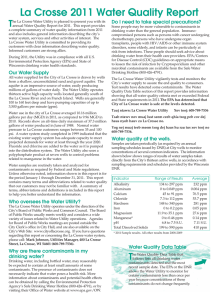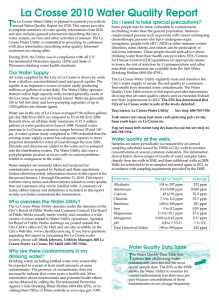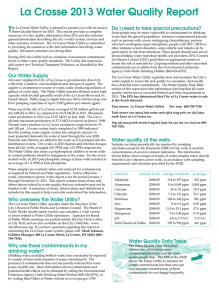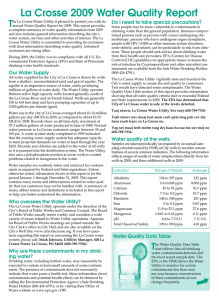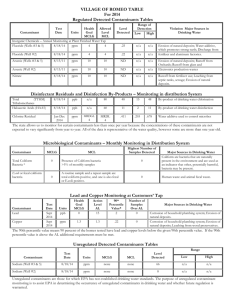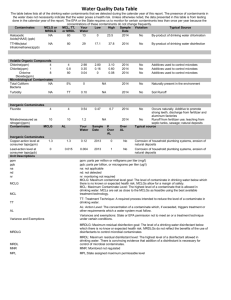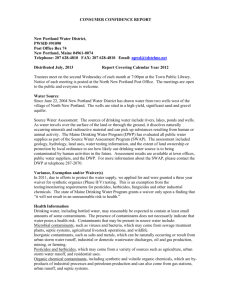T Do I need to take special precautions?
advertisement
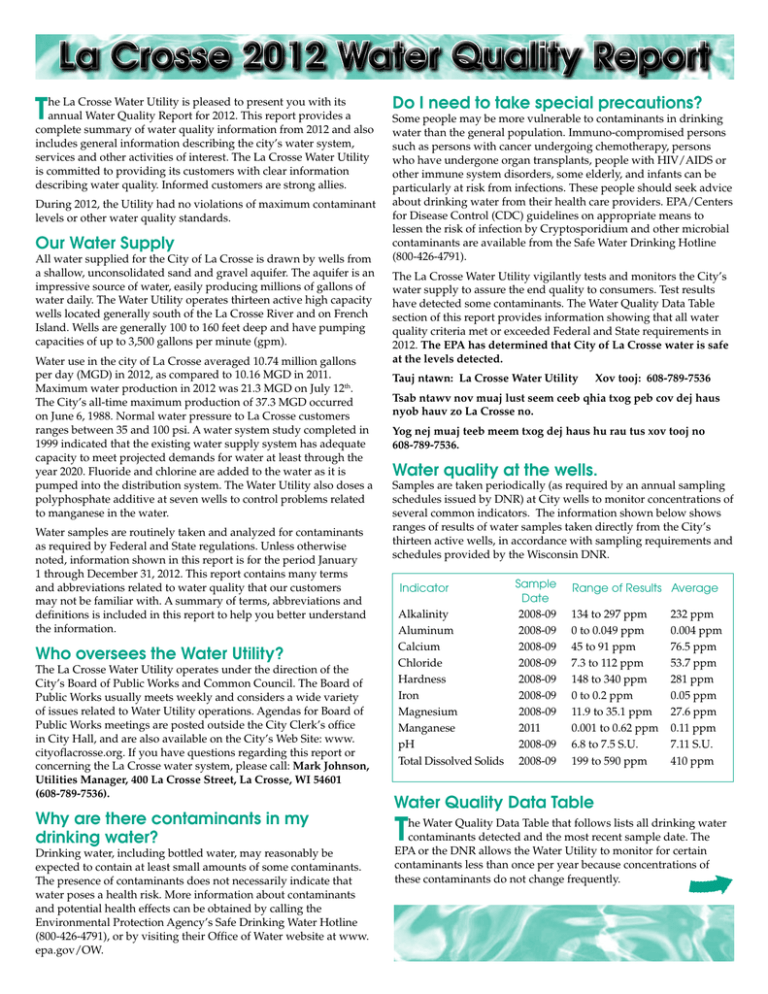
T he La Crosse Water Utility is pleased to present you with its annual Water Quality Report for 2012. This report provides a complete summary of water quality information from 2012 and also includes general information describing the city’s water system, services and other activities of interest. The La Crosse Water Utility is committed to providing its customers with clear information describing water quality. Informed customers are strong allies. During 2012, the Utility had no violations of maximum contaminant levels or other water quality standards. Our Water Supply All water supplied for the City of La Crosse is drawn by wells from a shallow, unconsolidated sand and gravel aquifer. The aquifer is an impressive source of water, easily producing millions of gallons of water daily. The Water Utility operates thirteen active high capacity wells located generally south of the La Crosse River and on French Island. Wells are generally 100 to 160 feet deep and have pumping capacities of up to 3,500 gallons per minute (gpm). Water use in the city of La Crosse averaged 10.74 million gallons per day (MGD) in 2012, as compared to 10.16 MGD in 2011. Maximum water production in 2012 was 21.3 MGD on July 12th. The City’s all-time maximum production of 37.3 MGD occurred on June 6, 1988. Normal water pressure to La Crosse customers ranges between 35 and 100 psi. A water system study completed in 1999 indicated that the existing water supply system has adequate capacity to meet projected demands for water at least through the year 2020. Fluoride and chlorine are added to the water as it is pumped into the distribution system. The Water Utility also doses a polyphosphate additive at seven wells to control problems related to manganese in the water. Water samples are routinely taken and analyzed for contaminants as required by Federal and State regulations. Unless otherwise noted, information shown in this report is for the period January 1 through December 31, 2012. This report contains many terms and abbreviations related to water quality that our customers may not be familiar with. A summary of terms, abbreviations and definitions is included in this report to help you better understand the information. Who oversees the Water Utility? The La Crosse Water Utility operates under the direction of the City’s Board of Public Works and Common Council. The Board of Public Works usually meets weekly and considers a wide variety of issues related to Water Utility operations. Agendas for Board of Public Works meetings are posted outside the City Clerk’s office in City Hall, and are also available on the City’s Web Site: www. cityoflacrosse.org. If you have questions regarding this report or concerning the La Crosse water system, please call: Mark Johnson, Utilities Manager, 400 La Crosse Street, La Crosse, WI 54601 (608-789-7536). Why are there contaminants in my drinking water? Drinking water, including bottled water, may reasonably be expected to contain at least small amounts of some contaminants. The presence of contaminants does not necessarily indicate that water poses a health risk. More information about contaminants and potential health effects can be obtained by calling the Environmental Protection Agency’s Safe Drinking Water Hotline (800-426-4791), or by visiting their Office of Water website at www. epa.gov/OW. Do I need to take special precautions? Some people may be more vulnerable to contaminants in drinking water than the general population. Immuno-compromised persons such as persons with cancer undergoing chemotherapy, persons who have undergone organ transplants, people with HIV/AIDS or other immune system disorders, some elderly, and infants can be particularly at risk from infections. These people should seek advice about drinking water from their health care providers. EPA/Centers for Disease Control (CDC) guidelines on appropriate means to lessen the risk of infection by Cryptosporidium and other microbial contaminants are available from the Safe Water Drinking Hotline (800-426-4791). The La Crosse Water Utility vigilantly tests and monitors the City’s water supply to assure the end quality to consumers. Test results have detected some contaminants. The Water Quality Data Table section of this report provides information showing that all water quality criteria met or exceeded Federal and State requirements in 2012. The EPA has determined that City of La Crosse water is safe at the levels detected. Tauj ntawn: La Crosse Water Utility Xov tooj: 608-789-7536 Tsab ntawv nov muaj lust seem ceeb qhia txog peb cov dej haus nyob hauv zo La Crosse no. Yog nej muaj teeb meem txog dej haus hu rau tus xov tooj no 608-789-7536. Water quality at the wells. Samples are taken periodically (as required by an annual sampling schedules issued by DNR) at City wells to monitor concentrations of several common indicators. The information shown below shows ranges of results of water samples taken directly from the City’s thirteen active wells, in accordance with sampling requirements and schedules provided by the Wisconsin DNR. Sample Date Alkalinity 2008-09 Aluminum 2008-09 Calcium 2008-09 Chloride 2008-09 Hardness 2008-09 Iron 2008-09 Magnesium 2008-09 Manganese 2011 pH 2008-09 Total Dissolved Solids 2008-09 Indicator Range of Results Average 134 to 297 ppm 0 to 0.049 ppm 45 to 91 ppm 7.3 to 112 ppm 148 to 340 ppm 0 to 0.2 ppm 11.9 to 35.1 ppm 0.001 to 0.62 ppm 6.8 to 7.5 S.U. 199 to 590 ppm 232 ppm 0.004 ppm 76.5 ppm 53.7 ppm 281 ppm 0.05 ppm 27.6 ppm 0.11 ppm 7.11 S.U. 410 ppm Water Quality Data Table T he Water Quality Data Table that follows lists all drinking water contaminants detected and the most recent sample date. The EPA or the DNR allows the Water Utility to monitor for certain contaminants less than once per year because concentrations of these contaminants do not change frequently. Water Quality Data Table YourRange Contaminants (units) MCLG MCL Water LowHigh Sample Date Violation Typical Source Inorganic Contaminants Arsenic (ppb) 0 10 3.9 n/d 3.9 2011 No Erosion of natural deposits; Runoff from orchards; Runoff from glass and electronics production wastes. Barium (ppm) 2 2 0.120 0.049 0.120 2011 No Discharge of drilling wastes; Discharge from metal refineries; Erosion of natural deposits. Cadmium (ppb) 5 5 0.0 n/d n/d 2011 No Corrosion of galvanized pipes; erosion of natural deposits; discharge from metal refineries; runoff from waste batteries and paints. Total Chromium (ppb) 100 100 1.3 n/d 1.3 2011 No Discharge from steel and pulp mills; Erosion of natural deposits; Corrosion of household plumbing systems. Fluoride (ppm) 4 4 1.7 0.1 1.7 2011 No Erosion of natural deposits; Water additive which promotes strong teeth. Mercury (ppb) 2 2 0.0 n/d n/d 2011 No Erosion of natural deposits; discharge of refineries and factories; runoff from landfills; runoff from cropland. Nickel (ppb) 100 100 6.0 1.2 6.0 2011 No Nickel occurs naturally in soils, ground water and surface waters and is often used in electroplating, stainless steel and alloy products. Nitrate [measured as 10 10 3.7 1.0 5.0 2012 No Runoff from fertilizer use; Leaching from Nitrogen] (ppm) (average) septic tanks, sewage; Erosion of natural deposits. Highest average from any individual sample site. Nitrite [measured as 1 1 0.0 n/d n/d 2011 No Runoff from fertilizer use; Leaching Nitrogen] (ppm) (average) from septic tanks, sewage; Erosion of natural deposits. Selenium (ppb) 50 50 3.9 n/d 3.9 2011 No Discharge from petroleum and metal refineries; erosion of natural deposits; discharge from mines. Thallium (ppb) 0.5 2 0.0 n/d n/d 2011 No Leaching from ore-processing sites; discharge from electronics, glass and drug factories. Unregulated Contaminants Sample Information Bromodichloro- NR NR 7.31 1.75 7.31 2012 No Range reflects highest results from methane (ppb) monitoring sites. Bromoform (ppb) NR NR 1.57 n/d 1.57 2012 No Range reflects highest results from monitoring sites. Chloroform (ppb) NR NR 10.4 0.58 10.4 2012 No Range reflects highest results from monitoring sites. Chlorodibromo- NR NR 5.62 1.39 5.62 2012 No Range reflects highest results from methane (ppb) monitoring sites. Sodium (ppm) NR NR 24.4 5.5 63.0 2011 No Erosion of natural deposits; Leaching (average) Sulfate (ppm) NR NR 22.6 9.5 37.0 2011 No All samples from wells. (average) Trichlorofluoro- NR NR 0.18 n/d 0.46 2012 No Highest average from any individual methane (ppb) (average) sampling site. Volatile Organic Contaminants Tetrachloroethylene (ppb) 0 5 1.3 n/d 1.7 2012 No (average**) Trichloroethylene (ppb) 0 5 0.7 n/d 0.8 2012 No (average**) 1,1-Dichloroethy- 7 7 0.1 n/d 0.2 2012 No lene (ppb) (average**) 1,1,1-Trichloroethane (ppb) 200 200 0.0 n/d 0.2 2012 No (average**) TTHMs (ppb) 0 80 22.1 6.1 22.1 2012 No [Total Trihalomethanes] Typical Source Discharge from factories and dry cleaners. Discharge from metal degreasing sites and other factories. Discharge from industrial chemical factories. Discharge from metal degreasing sites and factories. By-product of drinking water chlorination; samples fromdistribution system. Radioactivity Combined Uranium (ppb) 0 30 0.8 0.34 0.77 2009*** No Gross Alpha (Excl R & U) (pCi/l) 0 15 2.5 -0.1 2.5 2009*** No Gross Alpha (Incl R & U) (pCi/l) NR NR 2.8 0.44 2.8 2009*** No Radium (226 + 228) (pCi/l) 0 5 1.8 0.66 1.8 2009*** No Typical Source Erosion of natural deposits. ** Represents the highest average value from any individual sample site. Erosion of natural deposits. Erosion of natural deposits. Erosion of natural deposits. *** Four-quarter composite sampling completed in 2009. YourRange Contaminants (units) MCLG MCL Water LowHigh Sample Date Violation Typical Source Disinfection Byproducts HAA5 (ppb) 60 60 11.0 3.22 11.0 2012 No By-product of drinking water chlorina[Haloacetic Acid] tion; samples from distribution system. Your Contaminant(s) (units) MCLG AL* Water # of Samples greater than AL* Sample Date Exceeds AL Inorganic Contaminants Copper (ppm) 1.3 1.3 0.76 1 2011* No Lead (ppb) 0 15 3.0 1 2011* No Typical Source Erosion of natural deposits; Leaching; Corrosion of household plumbing systems; from wood preservatives. Corrosion of household plumbing systems; Erosion of natural deposits. * Sampled every three years. Microbiological Contaminants: Total 2012 samples from sites in the water distribution system Number of coliform detects in 2012 distribution system samples Total 2012 samples from water system production wells Number of coliform detects in 2012 production well samples 772 0 48 0 Synthetic Organic Chemicals—Source water samples taken in 2011 showed no detectable synthetic organic chemicals. Next scheduled samples for synthetic organic chemicals in 2014. Volatile Organic Chemicals—Water system samples taken in 2012 produced No Detects for these chemicals: Benzene, Bromobenzene, Bromomethane, Carbon Tetrachloride, Chlorobenzene, Chloroethane, Chloromethane, o-Chlorotoluene, p-Chlorotoluene, Dibromochloromethane, cis-1,2-Dichloroethylene, Dibromomethane,1,2-Dichlorobenzene (O-), 1,3-Dichlorobenzene (M-), 1,4-Dichlorobenzene (P-), 1,1-Dichloroethane, 1,2-Dichloroethane, trans-1,2-Dichloroethylene, Dichlorofluoromethane, Dichloromethane, 1,2-Dichloropropane, 1,3-Dichloropropane, 2,2-Dichloropropane, 1,1-Dichloropropene, 1,3-Dichloropropene, Ethyl Benzene, Styrene, 1,1,1,2-Tetrachloroethane, 1,1,2,2-Tetrachloroethane, Toluene, 1,2,4-Trichlorobenzene, 1,1,2-Trichloroethane, 1,2,3-Trichloropropane, Vinyl Chloride, Xylene Total. Lead: Infants and young children are typically more vulnerable to lead in drinking water than the general population. It is possible that lead levels at your home may be higher than at other homes in the community as a result of materials used in your home’s plumbing. If you are concerned about elevated lead levels in your home’s water, you may wish to have your water tested and flush your tap for 30 seconds to 2 minutes before using tap water. Additional information is available from the Safe Drinking Water Hotline (800-426-4791). Nitrates: Nitrates in drinking water at levels above 10 ppm is a health risk for infants of less than six months of age. High nitrate levels in drinking water can cause blue baby syndrome. Nitrate levels may rise quickly for short periods of time because of rainfall or agricultural activity. If you are caring for an infant you should ask advice from your health care provider. Terms and Abbreviations used in this report: MCLG (Maximum Contaminant Level Goal): The level of a contaminant in drinking water below which there is no known or expected risk to health. MCLGs allow for a margin of safety. MCL (Maximum Contaminant Level): The highest level of a contaminant that is allowed in drinking water. MCLs are set as close to the MCLGs as feasible using the best available treatment technology. MCLs are set at very stringent levels. To understand the possible health effects described for many regulated contaminants, a person would have to consume 2 liters of water every day at the MCL level for a lifetime to have a one-in-a-million chance of having the described health effect. *AL (Action Level): The concentration of a contaminant which, if exceeded, triggers a treatment or other requirement which a water system must follow. Systems exceeding a lead and/or copper action level must take actions to reduce lead and/or copper in the drinking water. The lead and copper values represent the 90th percentile of all compliance samples collected. If you want information on the Radon: Radon is a radioactive gas that you can’t see, taste, or smell. It is found throughout the U.S. Radon can move up through the ground and into a home through cracks and holes in the foundation. Radon can build up to high levels in all types of homes. Radon can also get into indoor air when released from tap water from showering, washing dishes, and other household activities. Compared to radon entering the home through soil, radon entering the home through tap water will in most cases be a small source of radon in indoor air. Radon is a known human carcinogen. Breathing air containing radon can lead to lung cancer. Drinking water containing radon may also cause increased risk of stomach cancer. If you are concerned about radon in your home, test the air in your home. Testing is inexpensive and easy. Fix your home if the level of radon in your air is 4 Picocuries per liter of air (pCi/L) or higher. There are simple ways to fix a radon problem that aren’t too costly. For additional information, call your state radon program or call EPA’s Radon Hotline (800-SOS-RADON). number of sites or the actions taken to reduce these levels, please contact the Water Utility office. Variances & Exemptions (V & E): State or EPA permission not to meet an MCL or a treatment technique under certain conditions. Non-Detects (n/d): Laboratory analysis indicates the constituent is not present. Not-Regulated (NR): State or EPA has not established a limit. Parts per million (ppm) or Milligrams per liter (mg/l): One part per million corresponds to one minute in two years or one penny in $10,000. Parts per billion (ppb), or Micrograms per liter (µg/l): One part per billion corresponds to one minute in 2,000 years or one penny in $10,000,000. Picocuries per liter (pCi/l): Picocuries per liter is a measure of the radioactivity in water. Total Coliform Rule (TCR): Refers to EPA regulations for microbiological standards. Ongoing Water Utility Projects, Issues and Activities: The 2012 Water Quality Report includes a required Public Notice with important information about your drinking water. This Notice provides detailed information explaining alleged significant deficiencies related to the Utility’s cross-connection control program and describing actions being taken by the Utility to satisfy program compliance with regulatory requirements. Please review the Public Notice and contact Mark Johnson at the Utilities office, 400 La Crosse Street, La Crosse, WI 54601, 608-789-7536, with any questions. The Water Utility’s residential water meter replacement program includes a cross-connection control (CCC) inspection. This is a long-term program that requires property owners to schedule an appointment to allow the Utility to enter properties, access meters, and complete the required work. Meters and control valves must be accessible for meter exchanges and remain accessible at all times, and not just for access by the Water Utility. In the event a pipe bursts inside your home, quick and access to the shut-off valves may save extensive water-related damage to your property. The cross-connection control program is required under the Wisconsin Administrative Code. Additional detailed information describing the cross-connection control program is available on the Water Utility page of the City web site (www. cityoflacrosse.org). Use of City fire hydrants is allowed only under the conditions of the Water Utility’s Hydrant Use Policy. This policy is available on the City of La Crosse web page or by contacting the Water Utility office. If you observe ANY suspicious activity involving a fire hydrant or any part of the water system, please report this immediately to the Water Utility or to the Police Department. The Water Utility implemented a water rate increase that went into effect on August 1, 2011. Current rates are shown below. Sewer charges are in addition to water charges. Please visit the Water Utility page of the City website (www. cityoflacrosse.org) for other charges, as determined and approved as part of the 2011 PSC rate case, that may apply for specific or special services. The Water Utility flushes the entire water system annually to purge naturally occurring minerals and sediments that accumulate over time. These materials do not pose a health hazard but can discolor the water when the system is disrupted. Most system flushing is done at night, which allows use of wells that are normally off during the day and makes almost the full system capacity available for flushing. Night flushing has been very successful in significantly reducing daytime problems when water demand is highest. Please contact the Water Utility office with questions related to water system flushing and especially related to the night flushing procedure. The treatment method using a polyphosphate additive to sequester or ”tie-up” iron and manganese has been very successful in preventing customer problems related to discolored water. The Water Utility continues to work with its chemical supplier to optimize the treatment program and to evaluate new, possibly more effective additives. Please contact the Water Utility office with questions related to this water treatment method. The Water Utility is in the process of re-issuing new, five-year permits to properties with private wells that were compliant as of December 31, 2012. Similarly, enforcement action is underway for those properties having private wells that were noncompliance when the previous five-year permit period expired on December 31, 2012. City ordinance requires that each dwelling or other building used for human habitation has an individual connection for water service. A policy is in-place to address locations where properties share water service laterals. Under the policy, water service is extended to these locations when (1) any of the affected Fixed charges and Public Fire Protection (PFP) charges are based properties is sold, (2) a street project is planned for the location, on the size of the meter: or (3) a problem occurs with the shared service. Installation Meter Qtrly Qtrly MeterQtrly Qtrly Meter Qtrly Qtrly of new water services usually includes assessment of a Size Fixed PFP Size Fixed PFP Size Fixed PFP portion of the costs to the property owner. Property owners 5/8” $22.50 $8.25 1-1/2”$69.00 $41.10 6” $342.00 $411.00 should contact the Utilities office if they have reason to 3/4” $22.50 $8.25 2” $99.00 $66.00 8” $546.00$657.00 believe they share a water service with another property, or 1” $39.00 $20.70 3” $159.00 $123.00 10” $768.00$984.00 1-1/4” $30.30 4” $216.00 $207.00 12” $990.00$1311.00 with questions related to the requirements for individual service connections. Fixed charges for Public Fire Protection (PFP) were implemented Water meters include a built-in “leak indicator” on the face of the as of January 1, 2010. The Water Utility page of the City web site meter to provide a quick method to check for possible, internal includes information explaining Public Fire Protection charges. leaks. Leak indicators are a small, blue dial, usually diamond or Usage charges are based on the amount of water used, as recorded by water meters. Water usage is billed based on the number of “units” used. One unit = 100 cubic feet = 748 gallons of water The first 5,000 cubic feet (50 units) of water is billed at $1.02 per unit. The next 70,000 cubic feet (700 units) of water is billed at $0.82 per unit The next 225,000 cubic feet (2,250 units) of water is billed at $0.75 per unit Over 300,000 cubic feet (3,000 units) of water is billed at $0.52 per unit star-shaped. If a property owner believes that all water use inside the building is off and the leak indicator is still turning, this shows that water is passing through the meter to some internal use. Property owners may contact the Utilities office (608-7897536) to schedule a no-charge service appointment for assistance in finding internal water leaks. Please visit the Water Utility page of the City web site (www. cityoflacrosse.org) for additional information related to the City water system. or contact the Water Utility office (608-789-7536) with questions.
